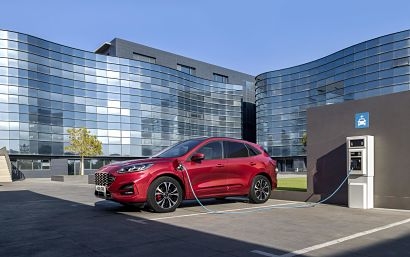
The Kuga Titanium, Kuga ST‑Line and Kuga Vignale will offer an advanced range of hybrid powertrains while the comprehensive line-up includes the Kuga Plug-In Hybrid, Kuga EcoBlue Hybrid (mild-hybrid) and Kuga Hybrid (full-hybrid) variants.
The move follows Ford’s announcement earlier this year that every Ford nameplate from all-new Focus onwards will include an electrified option.
The all-new Kuga Plug-In Hybrid delivers the driving range and freedom offered by a traditional combustion engine alongside the efficiency and refinement of an electric powertrain. The power-split architecture combines a 2.5-litre, four-cylinder Atkinson-cycle petrol engine, electric motor and generator, and 14.4 kWh lithium-ion battery to produce 225PS. Ford’s first plug-in hybrid in Europe to deliver a pure-electric driving range in excess of 31 miles, the Kuga Plug-In Hybrid is anticipated to deliver from 1.2 l/100km fuel-efficiency and 29 g/km CO2 emissions.
The battery can be charged using a front fender-mounted charging port, and is automatically replenished on the move using regenerative charging technology that captures kinetic energy normally lost during braking. It is anticipated that to fully charge the battery from an external 230-volt electricity supply will take around 4 hours.
Drivers can choose when and how to deploy battery power using EV Auto, EV Now, EV Later and EV Charge modes. When the battery reaches its lowest state-of-charge, the Kuga automatically reverts to EV Auto mode – supplementing petrol engine power with electric motor assistance using recaptured energy for optimised fuel-efficiency.
Kuga EcoBlue Hybrid: The all-new Kuga EcoBlue Hybrid enhances Ford’s 150PS 2.0‑litre EcoBlue diesel engine for even greater fuel-efficiency. The mild-hybrid technology employs a belt-driven integrated starter/generator (BISG) that replaces the standard alternator, enabling recovery and storage of energy during vehicle decelerations, and charging a 48-volt lithium-ion air-cooled battery pack. The BISG also acts as a motor, using the stored energy to provide electric torque assistance to the engine under normal driving and acceleration, as well as running the vehicle’s electrical ancillaries.
The 48-volt system also enables the all-new Kuga’s Auto Start-Stop technology to operate in more situations for additional fuel savings, contributing to anticipated CO2 emissions from 132 g/km CO2 and 5.0 l/100km (anticipated 56mpg) fuel-efficiency.
Kuga Hybrid: The Kuga Hybrid uses a self-charging full-hybrid powertrain that enables pure-electric driving capability and combines a 2.5-litre Atkinson cycle petrol engine; electric motor; generator; lithium-ion battery; and a Ford-developed power-split automatic transmission. The Kuga Hybrid will be available later in 2020 with front-wheel drive and Ford Intelligent All-Wheel Drive, delivering from an anticipated 130 g/km CO2 and 5.6 l/100km (anticipated 50mpg).
In other news, Ford has also delivered an innovative new new plug-in hybrid version of the Tourneo Custom people-mover at a special “Go Further” event in Amsterdam, Netherlands. The vehicle will be available to European customers from late 2019 and is among the first models unveiled as part of Ford’s strategy to deliver one of the most encompassing line-ups of electrified options for European customers. The vehicle can be charged with mains electricity for zero-emission driving – contributing to reduced local emissions and allowing the eight-seat people-mover to enter the growing number of ultra-low-emission vehicle zones being introduced across Europe.
For additional information:

